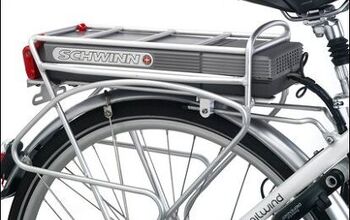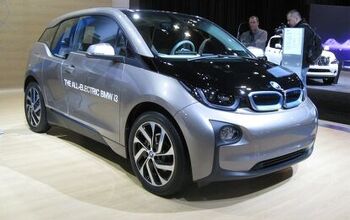BMW: The Ultimate Range Anxiety Cure?
The Tesla vs. New York Times controversy has finally left the news cycle, forgotten in less time than it takes a Model S to juice up at a Supercharger station. Meanwhile, BMW is ready to introduce its new range of “i” vehicles, which will conveniently dodge the whole question of range anxiety.
Select European outlets were invited for ride-alongs in BMW’s new i3 city car and i8 supercar. The impressions gleaned from ride-alongs are generally next to worthless, but the technology being used by BMW is worth examining. Rather than a pure EV, BMW will be adopting a three-pronged approach – a pure EV, a range extender and a plug-in hybrid.
The i3, a small hatchback meant for urban driving, will adopt the BMW ActiveE’s drivetrain, with an electric motor mounted in the rear, making 168 horsepower and 184 lb-ft of torque. Maximum range is said to be 140 miles, though 80-100 miles is a more realistic figure according to BMW. The i3 will be slightly bigger than a Mini Cooper, but will weigh just 2750 lbs and git 60 mph in 7.2 seconds. And unlike the Mini, it’s rear-drive.
But the most interesting aspect of the i3 is the range extender option. Unlike the plug-in hybrid option on the i8 supercar (which uses a three-cylinder turbocharged engine and an electric motor to power the wheels), the range extender in the i3 is strictly used to help maintain the battery’s charge if it falls below a predetermined level. It does not power the drive wheels under any circumstances. The 650cc parallel-twin could help increase the i3’s range to as much as 200 miles according to BMW, though specifics were scant.
As much as pure EV enthusiasts may scoff at the idea of any carbon-emitting technology sullying the zero-emissions dream, range extender technology could become prominent as a means of expanding the viability of electric vehicles. Small motorcycle engines (like the i3) and even rotary engines are being floated as possible solutions, while other more radical possibilities are being researched right now. Serenergy, a Danish firm, makes a fuel cell system based on methanol that could be adopted for this purpose. While methanol fell out of vogue in the 90s, the prospect of creating it from sources like solid waste has helped revive interest in methanol as a biofuel. On a broader scale, range extenders could alleviate one of the main psychological deterrents to EV adoption – the fear of running out of juice, rendering you totally stranded – by offering a reliable fail-safe in case of battery depletion. And if it’s a rear engine, rear drive compact, all the better for those of us who still enjoy the act of driving.
More by Derek Kreindler
Latest Car Reviews
Read moreLatest Product Reviews
Read moreRecent Comments
- TheEndlessEnigma Of course they should unionize. US based automotive production component production and auto assembly plants with unionized memberships produce the highest quality products in the automotive sector. Just look at the high quality products produced by GM, Ford and Chrysler!
- Redapple2 Got cha. No big.
- Theflyersfan The wheel and tire combo is tragic and the "M Stripe" has to go, but overall, this one is a keeper. Provided the mileage isn't 300,000 and the service records don't read like a horror novel, this could be one of the last (almost) unmodified E34s out there that isn't rotting in a barn. I can see this ad being taken down quickly due to someone taking the chance. Recently had some good finds here. Which means Monday, we'll see a 1999 Honda Civic with falling off body mods from Pep Boys, a rusted fart can, Honda Rot with bad paint, 400,000 miles, and a biohazard interior, all for the unrealistic price of $10,000.
- Theflyersfan Expect a press report about an expansion of VW's Mexican plant any day now. I'm all for worker's rights to get the best (and fair) wages and benefits possible, but didn't VW, and for that matter many of the Asian and European carmaker plants in the south, already have as good of, if not better wages already? This can drive a wedge in those plants and this might be a case of be careful what you wish for.
- Jkross22 When I think about products that I buy that are of the highest quality or are of great value, I have no idea if they are made as a whole or in parts by unionized employees. As a customer, that's really all I care about. When I think about services I receive from unionized and non-unionized employees, it varies from C- to F levels of service. Will unionizing make the cars better or worse?

































Comments
Join the conversation
So does dropping a Harley V Twin in one of these now become the equivalent of dropping a 350 in a Jag? Also, is this a clean sheet motor or is it based off one of their bikes? The BMW 650 motorcycle engine is a single. I think the 850 is a twin and both are built by Rotax if I am not mistaken. Also, all of the "put the motor on a trailer" crowd need to drive around with a trailer. There are some simple logistics in play here...simply parking and backing up for example. Most posters here I'm sure have no issue backing up with a small trailer, but most drivers aren't posters here.
A few years ago, a man hacked off the back half of a 1978 Volkswagen Rabbit, powered by a 52 horsepower diesel engine. It has a stock three-speed automatic transmission, axles, and CV joints, all connected to the front wheels as a front-wheel-drive vehicle. He attached a trailer tongue to it, and used it as a trailer that is towed behind the EV, (a converted 1981 Rabbit) just like an ordinary utility trailer. The emissions testing etc had already been done by VW. Probably not something one would want to drive on a snow-covered road with lots of turns, but for freeway touring in reasonable conditions, it worked well. http://www.mrsharkey.com/pusher.htm